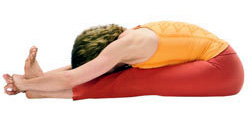|
|
|
What is
Pascimottanasana? |
|
It is a
seated forward bend that stretches the back and spine, shoulders and
hamstrings. The name has been drawn from Sanskrit Pascima means back
or west and uttana means extension thus literally it means intense
stretch of the back or west. It is an excellent posture for abdominal
area. |
|
|
|
|
 Yoga and Ayurveda Tour
Yoga and Ayurveda Tour |
|
|
|
How to
do Pascimottanasana or what is the technique of Pascimottanasana?
|
|
This asana looks simple, but is in fact one of the most difficult
asanas to do thus demands proper guidance and practice. Start with
sitting straight in with your spine upright. Stretch your both legs in
front of you and keep hands by the side, palms resting on the ground.
Fingers should remain together pointing forward. Now inhale and raise
both arms forward and up alongside your ears, fingers pointing
upwards. Exhale and bend forward from your hips, keeping the spine
extended. |
 |
|
|
Loosen
your back muscles and bend the body forward as far as it is possible.
Remain in this pose for four to 12 steady breaths. Practice it daily and
keep bending forward little more. Finally hold the big toes of the legs
with forefingers of respective hands and place forehead on the knees. This
is the extreme posture and can be achieved with lot of practice, beginners
should not try to stretch beyond their comfort level. |
|
|
|
What
are the benefits of practicing Pascimottanasana? |
|
1.This
asana strengthens the abdominal muscles and helps to cure constipation,
dyspepsia and seminal weaknesses.
2. It also removes the possibilities of sciatica.
3. It is highly recommended for women as it benefits the ovaries and
uterus and also helps to ease menstrual discomfort.
It is also beneficial for kidneys, liver, and diabetes. |
|
|
|
What
are the cautions? |
|
1. People suffering from chronic constipation
should not practice it for more than three minutes daily.
2. If you have ulcer in abdomen then this asana should not be practiced.
3. Do not practice it if you have back problems, asthma or diarrhea.
|
|
|
|
|
|
|
|
|
|
|
|
|

